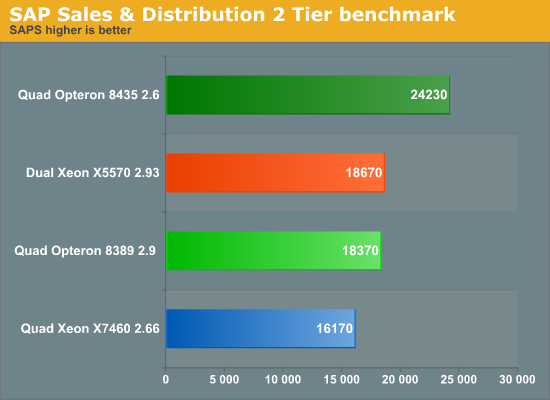Expensive Quad Sockets vs. Ubiquitous Dual Sockets
by Johan De Gelas on October 6, 2009 1:00 AM EST- Posted in
- IT Computing
SAP S&D 2-Tier
| SAP S&D 2-Tier | |
| Operating System | Windows 2008 Enterprise Edition |
| Software | SAP ERP 6.0 Enhancement package 4 |
| Benchmark software | Industry Standard benchmark version 2009 |
| Typical error margin | Very low |
The SAP SD (sales and distribution, 2-tier internet configuration) benchmark is an interesting benchmark as it is a real world client-server application. We decided to take a look at SAP's benchmark database. The results below all run on Windows 2003 Enterprise Edition and MS SQL Server 2005 database (both 64-bit). Every "2-tier Sales & Distribution" benchmark was performed with SAP's latest ERP 6 enhancement package 4. These results are NOT comparable with any benchmark performed before 2009. The new "2009" version of the benchmark obtains scores which are 25% lower. We analyzed the SAP Benchmark in-depth in one of our previous server oriented articles. The profile of the benchmark has remained the same:
- Very parallel resulting in excellent scaling
- Low to medium IPC, mostly due to "branchy" code
- Somewhat limited by memory bandwidth
- Likes large caches (memory latency!)
- Very sensitive to sync ("cache coherency") latency
And here are the results:

Some of you may have already made this analysis: the one year old Quad Xeon platform is outperformed by servers which are three times cheaper. The best dual Xeon makes the Quad Xeon look ridiculous as it outruns the latter by 15%. The Quad Opteron 2389 2.9 is getting a beating too, but his big brother, the Opteron 8435, takes revenge by running circles around the Intel hex-core: it is no less than 50% faster!
While performance is not the only factor to consider, the least you expect from a quad platform is that it offers somewhat better performance than a cheaper dual socket. This is exactly what we have been discussing in our "General IT" blog: the hex-core Opteron may tip the balance back in favor of a quad socket platform for a part of the server market. We are not impressed by the 30% performance advantage of a 24-core over an 8-core, and those looking for the highest raw performance will probably be disappointed. But for a large part of the market, performance is only one of the factors, and the 30% extra may well be good enough to convince people to consider a quad socket platform. Other factors like more memory and expansion slots, slightly better RAS capabilities and less power for the same number of applications might make a quad socket server a better choice for those people.










32 Comments
View All Comments
Casper42 - Tuesday, October 6, 2009 - link
I know its late, but on page 4 of this article you say your using a Dual 2389 setup where each chip is Quad Core.Somehow that morphs into a "Quad Opteron 2389" on page 6 both in the text and in the graphic. Since a Quad 2xxx is not possible, is this a Dual 2389 or a Quad 8389?
Then on page 7 it becomes a Quad Opteron 8389
Am I losing my mind?
I see now that both a Quad 8389 and a Dual 2389 are listed in Page 4, but why on earth did you guys bounce back and forth so much between them?
JohanAnandtech - Tuesday, October 6, 2009 - link
You are not losing your mind. The Quad 2389 is a quad 8389 of course. I have fixed the error. Thanks.The dual sockets machines were mostly used to check how the software scales (MS SQL server, virtualization) and how the power consumption compares to the quad socket machines. I hope this makes it clear?